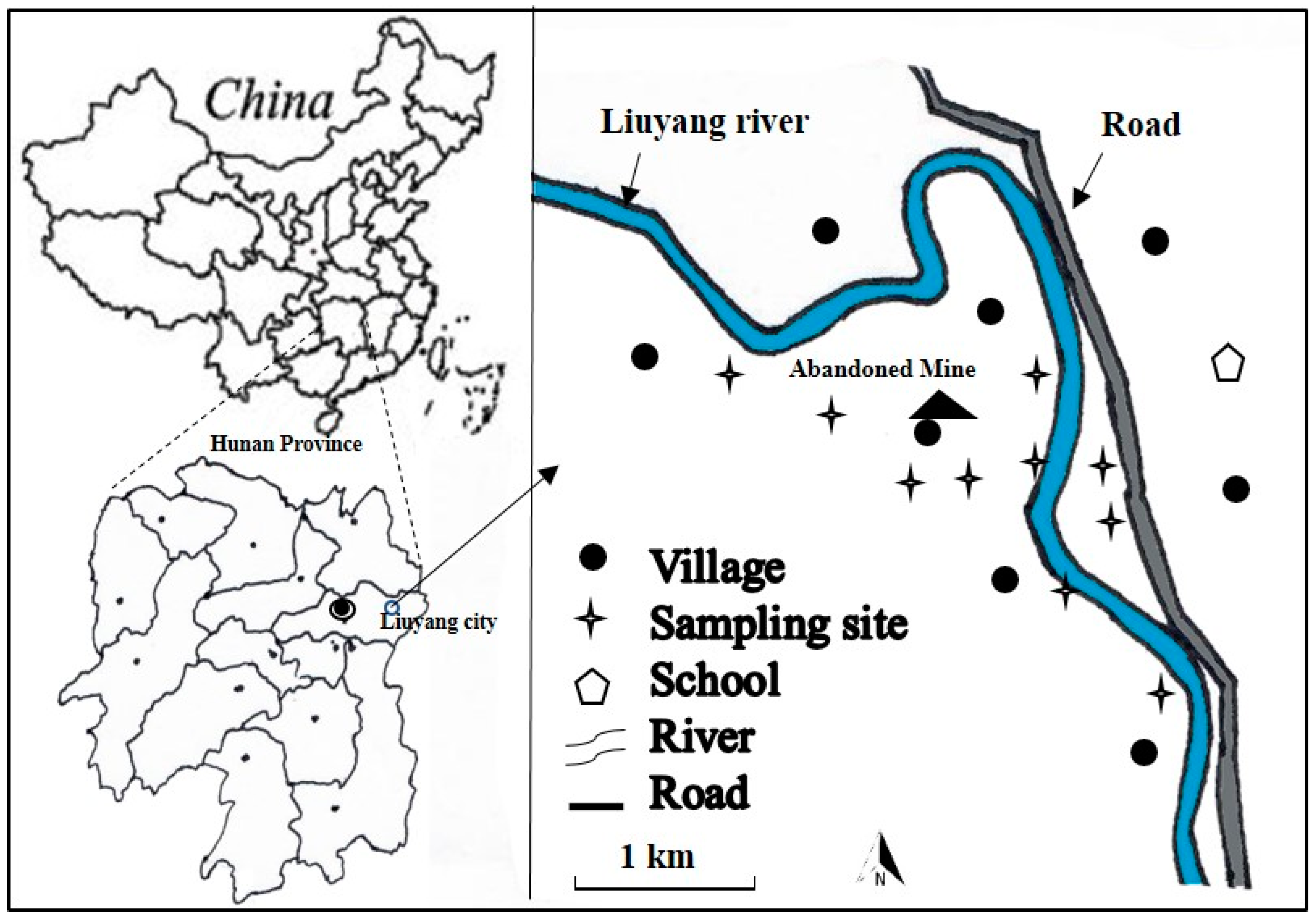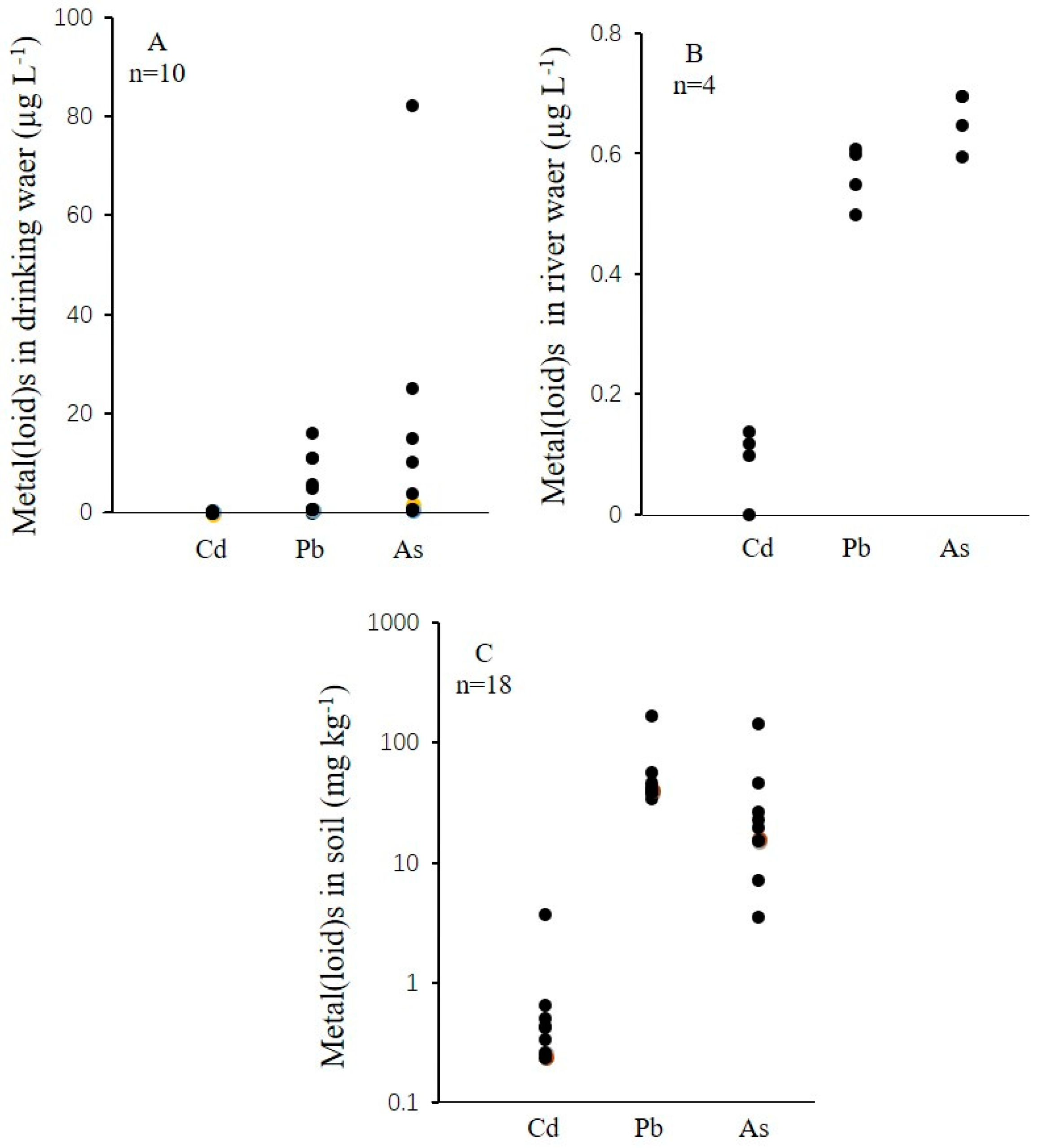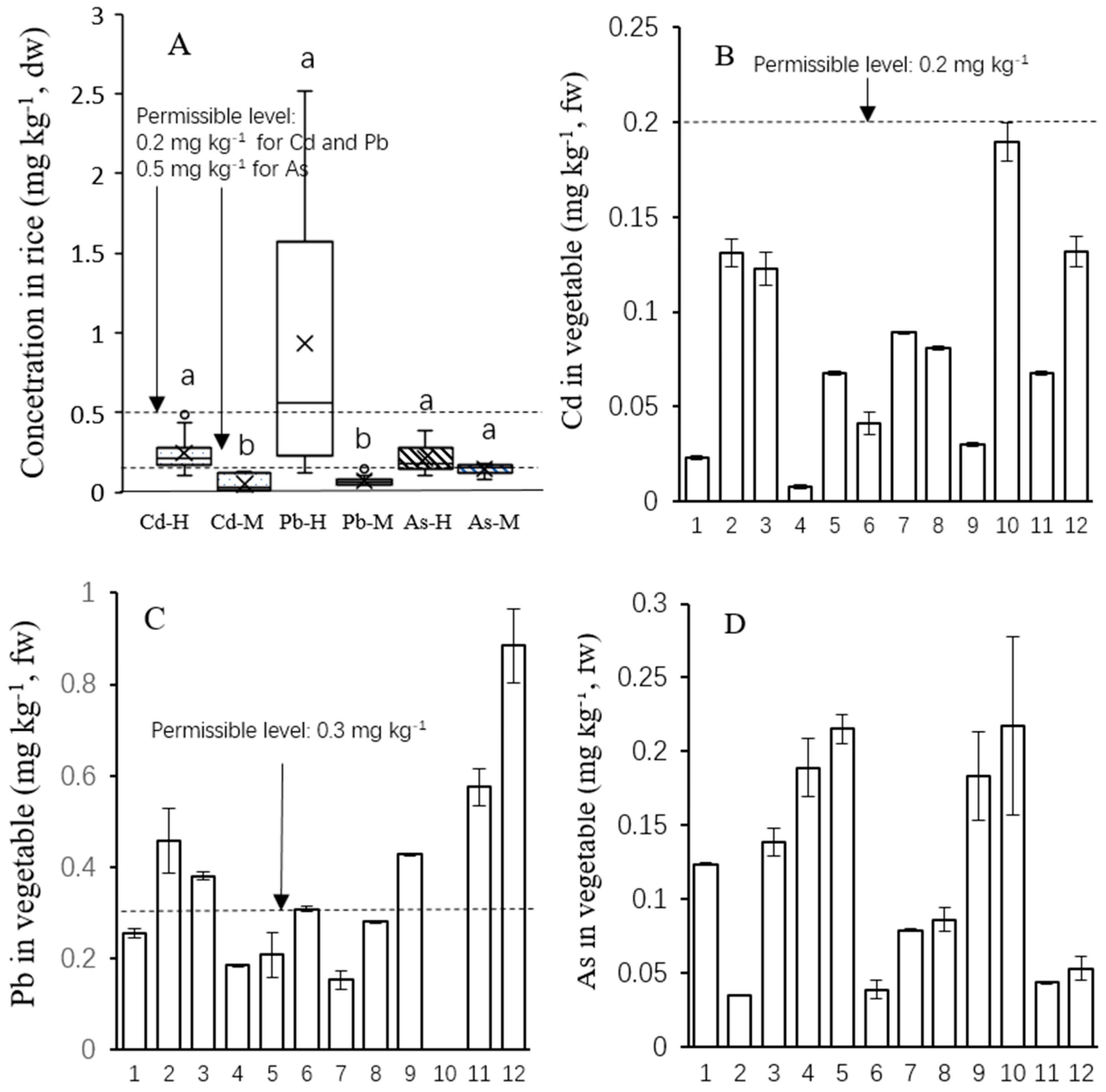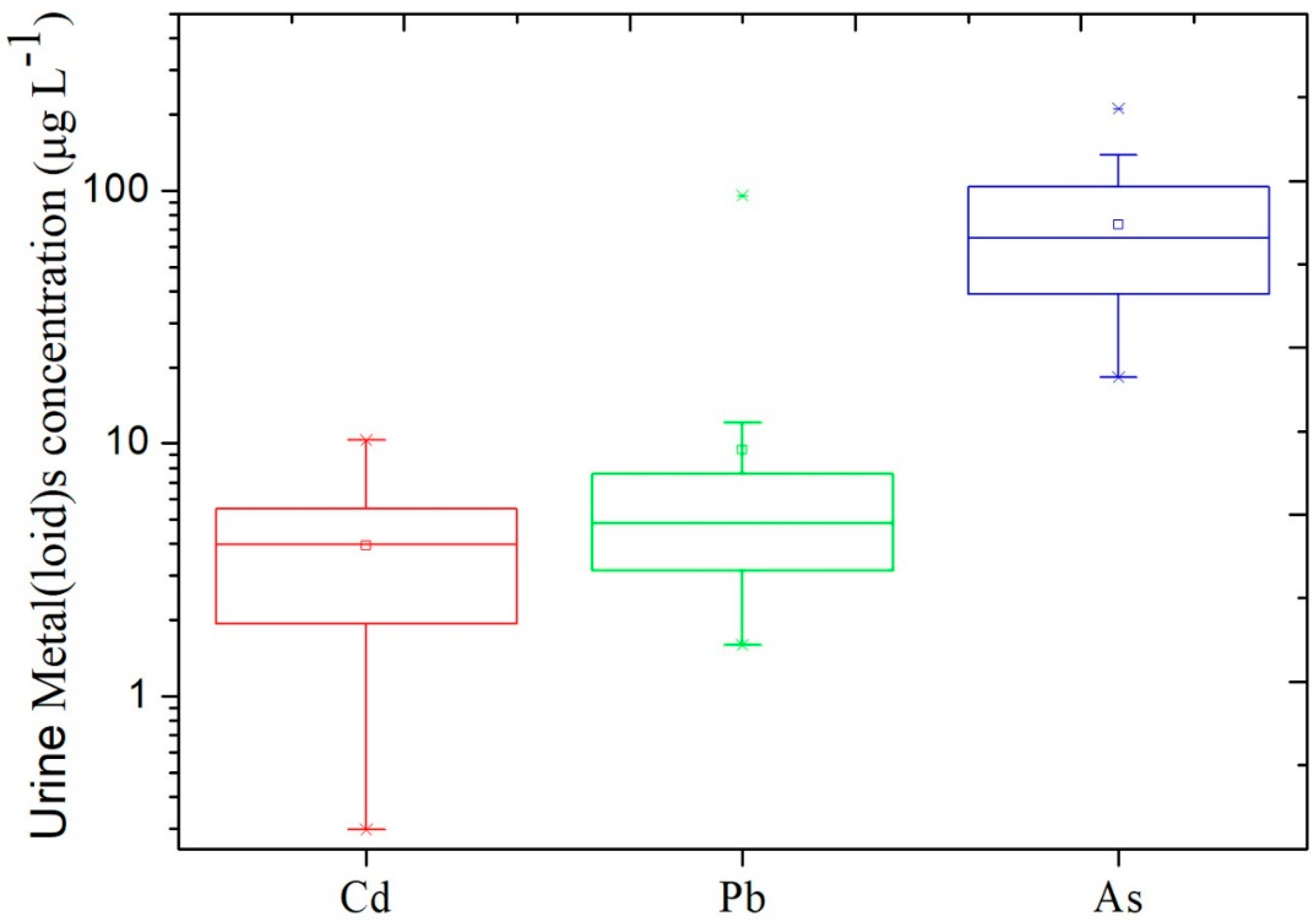Oral Bioaccessibility and Exposure Risk of Metal(loid)s in Local Residents Near a Mining-Impacted Area, Hunan, China
Abstract
1. Introduction
2. Materials and Methods
2.1. Study Area
2.2. Sampling, Pre-Treatment and Analysis
2.3. Evaluation of Bioaccessibility
2.4. Quality Assurance and Control
2.5. Data Analysis
3. Result and Discussion
3.1. Metal(loid) Concentrations in Environmental Samples and Food Crops
3.2. Metal(loid)s Bioaccessibility in Rice and Vegetables
3.3. Concentration of Cd, Pb and As in the Urine Samples
3.4. Contribution of Food Samples to Metal(loid)s Exposure in Humans
4. Conclusions
Supplementary Materials
Author Contributions
Acknowledgments
Conflicts of Interest
References
- Zhao, F.J.; Ma, Y.; Zhu, Y.G.; Tang, Z.; McGrath, S.P. Soil contamination in China: Current status and mitigation strategies. Environ. Sci. Technol. 2015, 49, 750–759. [Google Scholar] [CrossRef] [PubMed]
- Zhuang, P.; McBride, M.B.; Xia, H.; Li, N.; Li, Z. Health risk from heavy metals via consumption of food crops in the vicinity of Dabaoshan mine, South China. Sci. Total Environ. 2009, 407, 1551–1561. [Google Scholar] [CrossRef] [PubMed]
- Mohammed Abdul, K.S.; Jayasinghe, S.S.; Chandana, E.P.S.; Jayasumana, C.; De Silva, P.M.C.S. Arsenic and human health effects: A review. Environ. Toxicol. Pharmacol. 2015, 40, 828–846. [Google Scholar] [CrossRef] [PubMed]
- Degraeve, N. Carcinogenic, teratogenic and mutagenic effects of cadmium. Mutat. Res. 1981, 6, 115–135. [Google Scholar] [CrossRef]
- Järup, L. Hazards of heavy metal contamination. Br. Med. Bull. 2003, 68, 167–182. [Google Scholar] [CrossRef] [PubMed]
- Türkdoğan, M.K.; Kilicel, F.; Kara, K.; Tuncer, I.; Uygan, I. Heavy metals in soil, vegetables and fruits in the endemic upper gastrointestinal cancer region of Turkey. Environ. Toxicol. Pharmacol. 2003, 13, 175–179. [Google Scholar] [CrossRef]
- Kapusta, P.; Szarek-ŁUkaszewska, G.; Stefanowicz, A.M. Direct and indirect effects of metal contamination on soil biota in a Zn-Pb post-mining and smelting area (S Poland). Environ. Pollut. 2011, 159, 1516–1522. [Google Scholar] [CrossRef] [PubMed]
- Park, J.H.; Choi, K.K. Risk assessment of soil, water and crops in abandoned Geumryeong mine in South Korea. J. Geochem. Explor. 2013, 128, 117–123. [Google Scholar] [CrossRef]
- Zhuang, P.; Zou, B.; Li, N.Y.; Li, Z.A. Heavy metal contamination in soils and food crops around Dabaoshan mine in Guangdong, China: Implication for human health. Environ. Geochem. Health 2009, 31, 707–715. [Google Scholar] [CrossRef] [PubMed]
- Kang, Y.; Man, Y.B.; Cheung, K.C.; Wong, M.H. Risk Assessment of Human Exposure to Bioaccessible Phthalate Esters via Indoor Dust around the Pearl River Delta. Environ. Sci. Technol. 2012, 46, 8422–8430. [Google Scholar] [CrossRef] [PubMed]
- Yuan, X.; Wang, J.; Shang, Y.; Sun, B. Health risk assessment of cadmium via dietary intake by adults in China. J. Sci. Food Agric. 2014, 94, 373–380. [Google Scholar] [CrossRef] [PubMed]
- Zhu, P.; Liang, X.; Wang, P.; Wang, J.; Gao, Y.; Hu, S.; Huang, Q.; Huang, R.; Jiang, Q.; Wu, S.; et al. Assessment of dietary cadmium exposure: A cross-sectional study in rural areas of south China. Food Control 2016, 62, 284–290. [Google Scholar] [CrossRef]
- Zhuang, P.; Lu, H.; Li, Z.; Zou, B.; McBride, M.B. Multiple exposure and effects assessment of heavy metals in the population near mining area in South China. PLoS ONE 2014, 9, e94484. [Google Scholar] [CrossRef] [PubMed]
- Sun, H.; Wang, D.; Zhou, Z.; Ding, Z.; Chen, X.; Xu, Y.; Huang, L.; Tang, D. Association of cadmium in urine and blood with age in a general population with low environmental exposure. Chemosphere 2016, 156, 392–397. [Google Scholar] [CrossRef] [PubMed]
- Nordberg, G.F. Biomarkers of exposure, effects and susceptibility in humans and their application in studies of interactions among metals in China. Toxicol. Lett. 2010, 192, 45–49. [Google Scholar] [CrossRef] [PubMed]
- Menke, A.; Muntner, P.; Silbergeld, E.K.; Platz, E.A.; Guallar, E. Cadmium levels in urine and mortality among U.S. adults. Environ. Health Perspect. 2009, 117, 190–196. [Google Scholar] [CrossRef] [PubMed]
- Zhuang, P.; Li, Y.; Zou, B.; Su, F.; Zhang, C.; Mo, H.; Li, Z. Oral bioaccessibility and human exposure assessment of cadmium and lead in market vegetables in the Pearl River Delta, South China. Environ. Sci. Pollut. Res. 2016, 23, 24402–24410. [Google Scholar] [CrossRef] [PubMed]
- Zheng, F.Y.; Chen, L.H.; Li, S.X.; Qiu, Y.Q. Effect of edible plants combination on mineral bioaccessibility and bioavailability, using in vitro digestion and liposome-affinity extraction. Food Res. Int. 2013, 53, 174–179. [Google Scholar] [CrossRef]
- Wei, Y.; Zheng, X.; Shohag, J.; Gu, M. Bioaccessibility and human exposure assessment of cadmium and arsenic in pakchoi genotypes grown in co-contaminated soils. Int. J. Environ. Res. Public Health 2017, 14, 977. [Google Scholar] [CrossRef] [PubMed]
- Intawongse, M.; Dean, J.R. Use of the physiologically-based extraction test to assess the oral bioaccessibility of metals in vegetable plants grown in contaminated soil. Environ. Pollut. 2008, 152, 60–72. [Google Scholar] [CrossRef] [PubMed]
- Oomen, A.G.; Hack, A. Comparison of five in vitro digestion models to study the bioaccessibility of soil contaminants. Environ. Sci. Technol. 2002, 36, 3326–3334. [Google Scholar] [CrossRef] [PubMed]
- Ministry of Environmental Protection of the People’s Republic of China (MEPPRC). Farmland Environmental Quality Evaluation Standards for Edible Argricultural Products; HJ/T 332-2006; Ministry of Environmental Protection of the People’s Republic of China: Beijing, China, 2006.
- Zhuang, P.; Zhang, C.; Li, Y.; Zou, B.; Mo, H.; Wu, K.; Wu, J.; Li, Z. Assessment of influences of cooking on cadmium and arsenic bioaccessibility in rice, using an in vitro physiologically-based extraction test. Food Chem. 2016, 213, 206–214. [Google Scholar] [CrossRef] [PubMed]
- Zhao, D.; Liu, R.Y.; Xiang, P.; Juhasz, A.L.; Huang, L.; Luo, J.; Li, H.B.; Ma, L.Q. Applying Cadmium Relative Bioavailability to Assess Dietary Intake from Rice to Predict Cadmium Urinary Excretion in Nonsmokers. Environ. Sci. Technol. 2017, 51, 6756–6764. [Google Scholar] [CrossRef] [PubMed]
- Hu, J.; Wu, F.; Wu, S.; Cao, Z.; Lin, X.; Wong, M.H. Bioaccessibility, dietary exposure and human risk assessment of heavy metals from market vegetables in Hong Kong revealed with an in vitro gastrointestinal model. Chemosphere 2013, 91, 455–461. [Google Scholar] [CrossRef] [PubMed]
- Fu, J.; Cui, Y. In vitro digestion/Caco-2 cell model to estimate cadmium and lead bioaccessibility/bioavailability in two vegetables: The influence of cooking and additives. Food Chem. Toxicol. 2013, 59, 215–221. [Google Scholar] [CrossRef] [PubMed]
- Sun, G.X.; Van De Wiele, T.; Alava, P.; Tack, F.; Du Laing, G. Arsenic in cooked rice: Effect of chemical, enzymatic and microbial processes on bioaccessibility and speciation in the human gastrointestinal tract. Environ. Pollut. 2012, 162, 241–246. [Google Scholar] [CrossRef] [PubMed]
- Centers for Disease Control and Prevention (CDC). Fourth National Report on Human Exposure to Environmental Chemicals: Executive Summary; CDC: Atlanta, GA, USA, 2009.
- Lee, J.W.; Lee, C.K.; Moon, C.S.; Choi, I.J.; Lee, K.J.; Yi, S.M.; Jang, B.K.; Yoon, B.J.; Kim, D.S.; Peak, D.; et al. Korea National Survey for Environmental Pollutants in the Human Body 2008: Heavy metals in the blood or urine of the Korean population. Int. J. Hyg. Environ. Health 2012, 215, 449–457. [Google Scholar] [CrossRef] [PubMed]
- Higashikawa, K.; Zhang, Z.W.; Shimbo, S.; Moon, C.S.; Watanabe, T.; Nakatsuka, H.; Matsuda-Inoguchi, N.; Ikeda, M. Correlation between concentration in urine and in blood of cadmium and lead among women in Asia. Sci. Total Environ. 2000, 246, 97–107. [Google Scholar] [CrossRef]
- Diaz, O.P.; Arcos, R.; Tapia, Y.; Pastene, R.; Velez, D.; Devesa, V.; Montoro, R.; Aguilera, V.; Becerra, M. Estimation of arsenic intake from drinking water and food (Raw and cooked) in a rural village of Northern Chile. urine as a biomarker of recent exposure. Int. J. Environ. Res. Public Health 2015, 12, 5614–5633. [Google Scholar] [CrossRef] [PubMed]





| Metal(loid) | Parameter | Rice | Vegetables | Water | Over Exposure |
|---|---|---|---|---|---|
| Cd | Total (mg kg−1) | 0.254 | 0.081 (fw) | 0.0003 mg L−1 | |
| Bioaccessibility (%) a | 60.5 | 50 | 100 | ||
| Intake rate (day−1) b | 372 g | 274 g | 2 L | ||
| EDI (µg kg−1 bw day−1) | 0.95 | 0.18 | 0.01 | 1.14 | |
| Contribution rate (%) c | 114 | 22.2 | 1.2 | ||
| Pb | Total (mg kg−1) | 0.93 | 0.34 (fw) | 0.0059 | |
| Bioaccessibility (%) | 54.5 | 39 | 100 | ||
| Intake rate (day−1) | 372 g | 274 g | 2 L | ||
| EDI (µg kg−1 bw day−1) | 3.15 | 0.61 | 0.20 | 3.96 | |
| Contribution rate (%) d | 210 | 40.6 | 13.1 | ||
| As | Total (mg kg−1) | 0.204 | 0.164 (fw) | 0.0129 | |
| Bioaccessibility (%) | 88 | 44.8 | 100 | ||
| Intake rate (day−1) | 372 g | 274 g | 2 L | ||
| EDI (µg kg−1 bw day−1) | 1.11 | 0.34 | 0.43 | 1.88 | |
| Contribution rate (%) e | 37.1 | 11.1 | 14.3 |
© 2018 by the authors. Licensee MDPI, Basel, Switzerland. This article is an open access article distributed under the terms and conditions of the Creative Commons Attribution (CC BY) license (http://creativecommons.org/licenses/by/4.0/).
Share and Cite
Zhuang, P.; Sun, S.; Li, Y.; Li, F.; Zou, B.; Li, Y.; Mo, H.; Li, Z. Oral Bioaccessibility and Exposure Risk of Metal(loid)s in Local Residents Near a Mining-Impacted Area, Hunan, China. Int. J. Environ. Res. Public Health 2018, 15, 1573. https://doi.org/10.3390/ijerph15081573
Zhuang P, Sun S, Li Y, Li F, Zou B, Li Y, Mo H, Li Z. Oral Bioaccessibility and Exposure Risk of Metal(loid)s in Local Residents Near a Mining-Impacted Area, Hunan, China. International Journal of Environmental Research and Public Health. 2018; 15(8):1573. https://doi.org/10.3390/ijerph15081573
Chicago/Turabian StyleZhuang, Ping, Shuo Sun, Yingwen Li, Feng Li, Bi Zou, Yongxing Li, Hui Mo, and Zhian Li. 2018. "Oral Bioaccessibility and Exposure Risk of Metal(loid)s in Local Residents Near a Mining-Impacted Area, Hunan, China" International Journal of Environmental Research and Public Health 15, no. 8: 1573. https://doi.org/10.3390/ijerph15081573
APA StyleZhuang, P., Sun, S., Li, Y., Li, F., Zou, B., Li, Y., Mo, H., & Li, Z. (2018). Oral Bioaccessibility and Exposure Risk of Metal(loid)s in Local Residents Near a Mining-Impacted Area, Hunan, China. International Journal of Environmental Research and Public Health, 15(8), 1573. https://doi.org/10.3390/ijerph15081573




